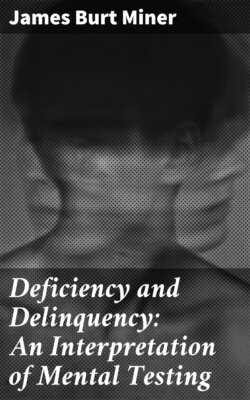Читать книгу Deficiency and Delinquency: An Interpretation of Mental Testing - James Burt Miner - Страница 14
ОглавлениеTable II. Mortality of Institutional Deficients in the United States Compared with the General Population, Showing its Possible Effect on the Frequency of Deficiency at Different Ages.
| Ages | ||||||||
|---|---|---|---|---|---|---|---|---|
| 5 | 10 | 15 | 20 | 25 | 30 | 35 | 40 | |
| General population | 1000 | 983 | 972 | 956 | 934 | 903 | 872 | 835 |
| Deficients in Institut'ns | 1000 | 795 | 696 | 606 | 503 | 428 | 349 | 290 |
| Per cent. deficient if 1% at age 15 | 1.40 | 1.11 | 1.00 | .75 |
Fig. 1. Mortality among Feeble-Minded in Institutions Compared With the General Population
A comparison of the death rates of the feeble-minded and the general population at different ages is of prime importance in connection with all attempts at quantitative descriptions of deficiency. Heretofore this has been completely neglected. Fig. 1 and Table II have been prepared to provide a roughly adequate estimate, on the basis of the above data for the United States, as to the survival of 1000 institutional cases of feeble-minded 5 years of age for successive age periods compared with 1000 people in the general population. In constructing this table it was necessary to assume, since the facts were not given, that the age distribution in the registration area of the general population was the same as for the United States as a whole (census of 1910) and that the number of feeble-minded in the institutions at the various age periods was equal to the number enumerated on the first of January plus the admissions during the year 1910, disregarding the number discharged since they are not distributed by ages. The average annual death rate among the institutional cases of feeble-minded 5 years of age and over in the United States in 1910 was 35.19 per thousand, while the corresponding death rate in the general population of the registration area for the five years 1901-1904 inclusive was 13.56. Assuming that the death rates are uniform within the five-year periods, the decline in the proportion of institutional feeble-minded from 5-25 years of age as the result of excessive mortality is indicated by the last line in Table II, after allowing for the mortality in the general population. That this effect of excessive mortality upon the percentage of feeble-minded cannot be neglected between 5 and 25 years of age is apparent unless the mortality among institutional cases is much greater than it is among the deficient generally. As the figures stand the proportion of feeble-minded would be reduced nearly one-half between ages 5 and 25. Only a small part of this reduction probably would be compensated for by new cases developing from accident or disease. On the other hand there is little doubt that the institutions contain an excessive proportion of low grade cases among whom the mortality is much greater. The mortality among institutional cases is, therefore, probably not typical of that among the feeble-minded generally. Nevertheless it is so great that any quantitative definition of deficiency which neglects it entirely is open to serious objection. We shall, therefore, keep this variation in mind in connection with the discussion in the next chapter of the percentage which is deficient, and in the adaptation of the definition to a measuring scale. It is clear that the percentage should be so chosen as to allow best for the possible large effect of excessive mortality among the deficients. Finally, it should be said that the percentage definition of feeble-mindedness might be modified to meet a varying percentage from age to age should that ever become desirable.
